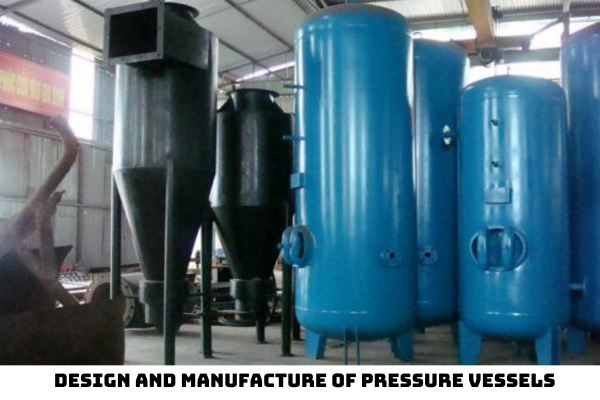Vietnam: What is the scope of application of National Standard TCVN 8366: 2010 on the design and manufacture of pressure vessels? Which pressure vessels does National Standard TCVN 8366: 2010 apply to?
- What is the scope of application of National Standard TCVN 8366: 2010 on the design and manufacture of pressure vessels in Vietnam?
- What are the general requirements for pressure vessels in Vietnam under National Standard TCVN 8366: 2010?
- Which pressure vessels in Vietnam does National Standard TCVN 8366: 2010 apply to?
What is the scope of application of National Standard TCVN 8366: 2010 on the design and manufacture of pressure vessels in Vietnam?
National Standard TCVN 8366: 2010 - Pressure vessels - Requirement of design and manufacture is compiled based on reference to AS 1210: 1997 on Pressure vessels.
During the review of National Standard TCVN 6153: 1996 to National Standard TCVN 6156: 1996 on pressure vessels, the Technical Committee of National Standard TCVN/TC 11 Boilers and Pressure Vessels found that the current Australian Boilers and Pressure Vessels (AS) standards were equivalent to American - ASME standards, available and suitable for current Vietnamese conditions. Countries in the region all apply ASME standards as national standards. Therefore, the compilation of National Standards on pressure equipment based on reference to AS standards is appropriate in today's integrated economy. In the coming time, National Standards on installing, using, and repairing pressure vessels and other related matters will be researched and compiled.
The layout and content of National Standard TCVN 8366: 2010 is basically equivalent to AS 1210: 1997. The reference documents and standards in National Standard TCVN 8366: 2010 use reference documents and standards in AS 1210: 1997 and equivalent, ensuring convenience for users and is suitable for the current conditions of Vietnam.
Accordingly, this National Standard specifies minimum requirements for materials, design, manufacture, testing, monitoring, certification and transfer of heated or unheated pressure vessels composed of ferrous or non-ferrous metals composed of ferrous or non-ferrous metals by welding, welding hard flakes, casting, forging, coating, lining and including the use of peripheral equipment necessary for the correct and safe operation of the pressure vessels. This National Standard also sets out requirements for non-metallic vessels and metal vessels with non-metallic linings.
The requirements of this National Standard have been formulated on the assumption that: during manufacture, the necessary inspections have been fully carried out; throughout the subsequent working period, the equipment was appropriately managed, including monitoring its deterioration.

What are the general requirements for pressure vessels in Vietnam under National Standard TCVN 8366: 2010?
Under subsection 1.2 Section 1 of National Standard TCVN 8366: 2010, the general requirements for pressure vessels in Vietnam under National Standard TCVN 8366: 2010 are specified as follows:
- Ensure reasonable safety for everyone involved in the operation of the equipment during its use as well as the safety of the property and the surrounding environment;
- Ensure an appropriate level of economy, performance, reliability, operability, and serviceability throughout the life of the tank;
- Control risks to at least meet the available regulations of safety, health, and environmental laws.
Which pressure vessels in Vietnam does National Standard TCVN 8366: 2010 apply to?
Under subsection 1.3 Section 1 of National Standard TCVN 8366: 2010 as follows:
Application
This National Standard applies to pressure vessels:
a) Having a design pressure above the graph line in Figure 1.3.1 and 1.3.2 but not exceeding 21 MPa for metal or non-metallic vessels composed of welding, forging, rigid flake welding, or casting unless otherwise agreed by the parties concerned, and
b/ Having operating temperatures within the temperature limits of materials and parts specified as appropriate in this standard
The following details are considered to be parts under pressure that must fall within the scope of application of this National Standard.
i) When the offline hoses are connected to the pressure vessels:
a) The welded edge connecting the pipe in circumference for welded joints;
b) The first threaded joint for a threaded joint;
c) The surface of the first flange for the joint is made of flanged bolts;
d) The first sealed surface for fittings assembly joints.
ii) Welds for attaching non-pressure parts to the vessel when these parts are welded directly to the inner or outer surface of the pressure vessel.
iii) Types of lids that are under pressure to be able to open the vessel such as underpass lids or hand holes.
iv) The kickers of the vessel are part of the vessel.
v) Protective devices, pressure release valves, and thermal protection at the request of buyers.
This National Standard does not apply to liquid tanks, large low-pressure gas tanks (as specified in ANSI/API Std 620), containers used in nuclear technology, machinery such as pumps and compressor housings, or vessels subjected to pressure caused solely by the stationary pressure of the tank, boiler tube, fire tube furnace, water pipe boiler, offline pipeline.
The requirements for pressure vessels according to advanced design and structure are given in Appendix 1 of TCVN 8366.
The relevant standards that offer alternatives to the requirements in this standard are AS 2971 and AS 3509 (within the scope of their application).
Parties applying this National Standard should note that the National Standard itself has no legal effect but it will become legally enforceable in the following cases:
1/ When this National Standard is accepted for use by a competent state agency or other competent authority.
2) When the buyer uses this National Standard as a requirement of the contract.
3) When the manufacturer declares that the pressure vessel is made according to this National Standard.
Thus, this National Standard applies to the above-mentioned pressure vessels.
LawNet